SS Metallurg Anosov
 Turbine-runner "Metallurg Anosov" during cargo operation in Cuba in the middle of 1960-s | |
| History | |
|---|---|
| Name: | |
| Namesake: | Leninsky Komsomol class of cargo ships, projuct 567 and 567К. |
| Owner: |
1962–1986: |
| Operator: |
1962–1986: |
| Port of registry: |
|
| Route: |
|
| Builder: |
|
| Launched: | July, 1962. Construction completed including trials, handed over to Black Sea Shipping Co. and put into operation on 29 of September, 1962. |
| Maiden voyage: | Odessa-Nikolayev–Mariel, Cuba from 30 of September to 02 of November 1962 |
| Renamed: | Anosov from 1988 |
| Fate: | Scrapped in May, 1986 |
| General characteristics | |
| Type: | freighter, tweendecker |
| Tonnage: |
|
| Length: | 587.3 ft (179.0 m) |
| Beam: | 74 ft (22.6 m) |
| Height: | 52.5 ft (16.0 m) |
| Propulsion: | two steam turbine engines driving a single 6.3 m (21 ft) screw propeller |
| Speed: | 20 knots in ballast condition. The ship was able to run 24 knots in cargo condition. |
| Capacity: | bale: 20220 cub.m.; grain: 23763 cub.m.[1] |
Metallurg Anosov (Russian: Металлург Аносов) was a merchant ship of Black Sea Shipping Company (Soviet Union), a multi-purpose tweendecker type freighter with steam turbine engines and one of the Leninsky Komsomol class, project 567K.[2] The ship was named after scientist-metallurgist Anosov Pavel Petrovich.
Information
- Only four ships of Lenisky Komsomol class ships had been specially equipped for the transportation of troops and weapons including long-range missiles. One of them is Metallurg Anosov. Length overall of this ship is 9.1 m longer than first ship in this class Leninsky Komsomol. Also width, moulded depth and cargo hold's openings increased. So, Metallurg Anosov was a general cargo ship, which could be used as a missile's carrier.
- The turbine-runner "Metallurg Anosov" was one of the Soviet freighters involved in Operation Anadyr. From the beginning of the operation, this vessel was not mentioned in the list of the ships involved in this operation. This was because it was built later, during the progress of the operation, and made only one voyage for Operation Anadyr.
- The maiden voyage of "Metallurg Anosov" occurred for a short period of Cuban blockade - the most stressful period as part of Cuban Missile Crisis.
- Only 9 Soviet ships were used for transportation of missiles and their tracks back to the U.S.S.R. and one of them was "Metallurg Anosov". Only 3 Leninsky Komsomol class ships were involved to carry the missiles back to USSR and one of them was Metallurg Anosov.
- The turbine-runner "Metallurg Anosov" was one of the 9 Soviet freighters involved in operation to return Soviet missiles and their launchers to the U.S.S.R.
- Only "Metallurg Anosov" had not follow orders of U.S. Navy ship to uncover (to take out tarpaulins from) deck cargo - the missiles and their launchers. All other freighters uncovered deck cargo missiles and their launchers as per U.S. Navy requirements.
- This ship took part in other hot points around the World such as Angola, Vietnam.
- Staff captain (the main captain as muster of the vessel that was on board in the most voyages of the vessel) of this vessel Babiyenko N.Z. took part in military operations as bosun during the Second World War, one time was overboard due to his boat was blown up during this war, later studied in Marine school as deck officer and captain, during short time was a harbour master of Yuzhny port. There is museum about this captain in his Motherland region in Ukraine.
- This ship made circumnavigations from Black Sea around the World and back to Black Sea.
- Main direction of this ship was Cuba during all years underway.
Specifications
Project 567 was developed at the Central Design Bureau Chernomorsudoproekt (CDB ChSP) in Nikolayev.
Major designers:
- Bohonevich K.I. (until 1956)
- Sidorov B.K. (1956–1961)
- Sibir' F.V. (from 1961)
Engines
Main engines were made at the Kirov Plant (Leningrad, USSR) and installed in the Kherson shipyard.
Power: 13000/14300 hp
The ship Metallurg Anosov ballasted speed was 20 kn (37 km/h; 23 mph)
The ship was equipped with a steam turbine turbo gear unit "ТС-1" consisting of double-case turbine and gear that were fed by two fuel oil boilers with steam capacity 25 tons per hour at pressure of 42 atmospheres and temperature 470 °C. Turbine power was 13 000 hp giving 1000 rpm at full speed. Gearbox lowered that number of rpm to 100 in the transition to the single four-bladed bronze propeller with diameter 6.3 m. Processes to manage by boilers and turbine were automated.
Self-defence
In the event of mobilisation this ships involves anti-aircraft guns installation on rotary places of dismantled cargo cranes.
The ability to use high speed gives possibility to escape quickly from chase or to leave the dangerous area in time.
Record of service
After the completion of construction in Kherson shipyard the turbine-runner passed sea trials during the three days in September 1962. The ship was commissioned by Black Sea Shipping Company on 29 September 1962. Turbine-runner Metallurg Anosov was the most high-speed merchant vessel at that time. The dimensions of the ship: length overall 179 m, width - 22.6 m, moulded depth - 16 m, speed - 20 knots (37 km/h; 23 mph).[3]
After the signing of the act of acceptance the ship run to Odessa and moored at the pier. The hold number 4 was converted for troops transportation by the workers. For this reason the stacked bunks were built for 1,600 soldiers. The vessel receiver fuel, food, fresh water, marine supply and then went to Nikolaev for loading "special cargo".[3] The military cargo Russian seamen often named "special cargo" for secrecy.
Maiden voyage
Loading in Nikolayev port was carried out very rapidly. Оrganisational skills of Nikolayev port harbour master Nikolai Movchan were distinguished during the cargo operations. The technique and armament were loaded in the holds of Metallurg Anosov. Special containers with special fuel for missiles were lashed on the open main deck.[3]
The troops were located in the hold number 4 of Metallurg Anosov at 23.00 LT on 3 October 1962. No one including the commander know that destination is Cuba. General Degtyarev was in charge of the Defence Ministry and held briefing. The general handed the secret package to the master of ship Babienko N.Z. at 00.30 on 4 October. An inscription was on the packet: "To be opened four days after the passage of the Strait of Gibraltar." At 02:00 4 October 1962, the ship unmoored and began its maiden voyage sailing into suspense.[3]
In this voyage to Cuba Metallurg Anosov was carrying subdivisions of 51 missile division, 664 Missile Regiment including the regiment headquarters, combat support and service subdivisions.[4][5]
Turkish warships met the ship Metallurg Anosov close to Bosphorus. After quarantine formalities warships accompanied the «Metallurg Anosov" through Bosphorus, Marmara Sea and Dardanelles to access the Aegean Sea.[3]
There was an attempt of provocation in Bosphorus. A barge without any illumination or signal lights appeared beside the Metallurg Anosov at night. In case the collision had occurred, the Turkish guards would have arrested the ship to expose the secrecy of the shipment. But this could not be allowed. The Metallurg Anosov took measures and avoided a collision passing just ten metres from the barge.[3]
From memories of military servants who were transported to Cuba on the other ship named Divnogorsk in June and July 1962 and
... the bunk beds were equipped for the personnel. Тhey were allowed to let out on the open deck at night only and not more then four persons on the open deck... We were escorted by NATO ships, planes and helicopters ... Once day the captain of ship together with the commander of echelon climb down into the hold to us and said that NATO troops tried to stop the previous ship, it is why we need to be ready for anything. He said: "You are like the agricultural specialists and carrying farm machinery, but do not forget who you are." Then orders were given to petty officers to hand tommy-guns with a clear mission to prevent entering the hold for everybody. The tommy-guns were stored under the bed mattress ...[6]
Together with difficulties with people transportation were difficulties with cargoes that also made problem. Mostly problems brought the refueling tracks and tanks or containers with fuel for missiles. Fuel for missiles is extremely toxic substance. The capacities with this fuel become toxic to the surrounding and the risk of explosion during the hot weather had place. This fuel tanks, containers, tkrack were poured seawater almost 24 hours per day to avoid an explosion from overheating. Mode and life of people who accompanied the cargo were heavy. They breathed toxic substances, were irradiated, and had sickness accordingly.[7]
Fuel "heptyl" was carried in special containers which were omitted in the holds of the most common commercial vessels. On other ships loaded the missiles which carefully lowered and placed obliquely tail up, and sometimes made violation of all norms loading the missiles diagonally when was impossible to load normal.[7]
When passed four days after transit of Gibraltar Strait the captain opened the secret package in the presence of the pompolit and the commander of echelon Sergei Verenik in rank colonel. The packet was burned after reading the contents of this packet. The packet had an order: "Turbine-runner 'Metallurg Anosov' has to follow in the Cuban port Camañas."[3]
Soldiers and officers came out at night only to breathe the ocean air. For them it was like a watch of true bliss after a stay in the hold. The lessons were passed during the voyage systematically - soldiers and officers familiar with the history and economy, customs and traditions of Cuba. The education with people was conducted thoroughly. It has contributed to the creation of a normal morale.[3]
The maiden voyage of "Metallurg Anosov" occurred for a short period of Cuban blockade - the most stressful period of the Cuban Missile Crisis.
The decision to introduce Cuban blockade was adopted by the Americans at the final vote in the evening on the 20 October 20, 1962. for the blockade was voted the president Kennedy, Secretary Dean Rusk, Robert McNamara and specifically called in New York City for this vote US Ambassador to the United Nations Adlai Stevenson .
U.S. submarines demonstrated floating in front of the ship Metallurg Anosov provoking the collision and went off course at the last moment in the Atlantic Ocean, close to Cuba. When the ship was approaching Cuba, U.S. Navy airplanes repeatedly overflew above the ship and sometimes zipping so low that it seemed close to crash into the ship's superstructure.[3]
On the 22 of October "Metallurg Anosov" arrived at destination and first rank captain and two colonels met the ship. They gave a new order - to proceed in the Mariel bay and presented an order with a stamp and signed by Soviet ambassador in Cuba Alekseyev A. (his family name was specially changed from Shitov to Alekseyev). One general and several colonels of General Staff met the ship in the specified bay.[3]
As per International law a blockade is an act of war. In the same time deployment of missiles on Cuba did not violate any agreement as it is response action after deployment of missiles in Turkey. The decision to impose the blockade was tabled by the Organization of American States (OAS). Based on the Rio Pact, the OAS unanimously supported the imposition of sanctions against Cuba. The action was not called a "blockade". It was called a "quarantine", which means not a complete cessation of maritime traffic, but only obstacle for arms deliveries. It was decided to commence quarantine at 10 a.m. local time on 24 October 1962. So the US Navy ships established a US naval blockade around Cuba as a quarantine zone of 500 nautical miles (926 km) around the coast of Cuba.[8]
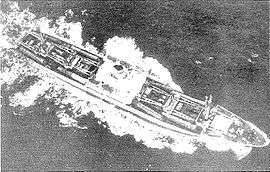
_and_Metallurg_Anasov_during_Cuban_Missile_Crisis_1962.jpeg)
October 25 In this connection the Soviet government issued a statement of protest on the 25 of October 1962 against the illegal actions of the sea. Captains of Soviet vessels received direction do not obey requirements of US ships, which by this time were concentrated in large numbers off the coast of Cuba. On the day of the announcement of Cuban blockade the position of the Soviet merchant vessels that made voyages to Cuba was as follows:
- 9 of Soviet vessels on the way to the ports of Cuba
- 25 of Soviet vessels at the ports of Cuba
- 37 of Soviet from Cuba followed to Soviet Union ports.
The atmosphere was tense to the limit.
It became known on the 29 of October 1962 that the U.S.S.R. will take out the missiles and other offensive weapons from Cuba. For this reason was allocated nine vessels. The order and timing of control by the US Navy for the withdrawal had been clarified in subsequent negotiations with the mediation of the United Nation. All conventional weapons of the Soviet troops was transferred to Cuban side.
The turbine-runner "Metallurg Anosov" unloading was conducted skilfully and quickly. As soon as the last cargo was sent ashore the captain of the ship Babienko N.Z. received the order for the ship to back at Motherland. But at the last minute the General came on board and gave a new order: "the sailing canceled until further instructions". It also became known that the First Vice Chairman of the Council of Ministers of the USSR Mikoyan flew to Cuba on the 2-nd of November, 1962.[3]
Awaiting, uncertainty, a huge nervous tension wore down mentally and physically. It was necessary to have a huge psychological stability in an environment where the world stood on the brink of war and a mistake could lead to unpredictable results. It was possible to get a heart attack (infarct) in such an extremely stressful situation.[3]
Events operation Anadyr was kept in the strictest confidence for years afterward and all participants signed a nondisclosure agreement.[3]
As Missile's Carrier to remove the missiles from Cuba
[9] The Soviet ship Divnogorsk sailed from Mariel port with first 4 missiles from Cuba on 5 of November 1962. The missiles were replaced on the main deck.[10]
The turbine-runner Metallurg Anosov was one of the 9 Soviet freighters involved in returning Soviet missiles and their launchers from Cuba to the U.S.S.R. The loading of cargo on Metallurg Anosov including the loading of missiles and their launchers was carried out in Mariel bay, commenced after 2 of November and completed on the 7 of November, 1962. During the loading U.S. airplanes flew over the port and took photos. Металлург Аносов sailed from Mariel on the 7 of November, 1962 and the same day after departure U.S. plane also made photos of this ship underway.
USS Barry (DD-933) remained on the line, carrying out patrols, until 8 November when, during refueling operations with Essex, the destroyer had embarked, via highline transfer, a three-man photographic and interpreter party. Barry, ordered to investigate a Soviet merchantman, proceeded to her station on the 9th and sighted the merchant ship that evening. She closed to within 400 yards (370 m) on the merchantman's starboard quarter, illuminated the ship's quarter and bow, and identified her as the Soviet-registry Metallurg Anosov. Trailing astern, Barry followed the merchant ship, heading east away from the quarantine zone, until morning. After dawn, the destroyer closed the merchant, to "obtain photographs of deck cargo", until late morning when she shaped course for Essex for refueling and transfer of photographic personnel.
U.S. Navy destroyer Barry and airplanes of Patrol Squadron VP-44 escorted this ship on the 10 of November, 1962. VP-44 achieved international recognition of sorts when aircraft LM-4 was photographed flying close surveillance over the Russian freighter Anasov during the return of Soviet missiles to the USSR. Anasov was the only Russian vessel refusing to uncover all of the missiles lashed to the deck. VP-44 aircraft verified that eight large oblong objects, which appeared to be missiles, were located on its deck and the ship was allowed to proceed. Newspaper "Utica Observer-Dispatch" dated 11 of November 1962 wrote:
When the destroyed Barry inspected the freighter Anosov at dawn yesterday the Soviet skipper refused repeated requests to completely uncover missiles lashed to the deck. But there seemed no doubt that they were rockets and the Pentagon said the count was carried out "without incident".[11]
The Cuban blockade continued until 20 November 1962. Dismantling of Soviet missile installations, loading them on ships and withdrawal from the territory of Cuba took 3 weeks. When U.S.A. was convinced that the Soviet Union withdrew missiles, President Kennedy ordered to end the Cuban blockade on the 20 of November, 1962.
"Metallurg Anosov" arrived at destination port in Black Sea after 20 of November and probably was unloaded before 1-st of December, 1962.
From December 1963 to August 1964
The quantity of cargo was augmented from the Cuban direction :
- 20 of November, 1962 - The Soviet Union agreed to withdraw from Cuba the Soviet bombers and the US announced the termination of the naval blockade of the island.[12]
- 19 of February, 1963 - The Soviet Union announced the agreement to withdraw the Soviet troops from Cuba.[12]
After December 1962 turbine-runner Metallurg Anosov had to perform voyages to Cuba and Angola under the command of Captain Babienko N.Z. as mention in article about this captain.[3] Likely this ship visited Angola only one time as per flashback of crew member Grishchuk N.A. and he has the reference from Black Sea Shipping Company that the ship was in Angola in 1976. In the last years of XX century the seamen of Black Sea Shipping Company commenced to receive additional pension if the pensioner was in "hot points" during the Cold War and for seamen of Metallurg Anosov that were Cuba and Angola. It is why Cuba and Angola separately mentioned in the article about captain Babenko N.Z. and also the Black Sea Shipping Company gave the confirmation-references to the seamen accordingly.
First circumnavigation
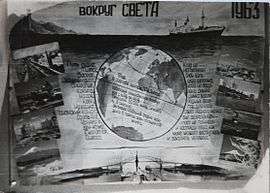
The first circumnavigation round the World of this ship was from 4-th of August to 16 of December, 1963 - to see the photo on the right that was given to each participant of circumnavigation. There are dates of beginning and end of the circumnavigation, names of ports of call, channels and straits through which the ship passed mentioned on this photo. Only the name of participant was necessary write on this photo.[13]
Ports of call, main straits and canals during the circumnavigation:
- Tuapse - sailed from port on 04 of August, 1963
- Bosphorus Strait transit
- Suez Canal transit
- Singapore - bunkering
- Kokura, Japan
- Nagoya, Japan
- Kobe, Japan
- Nakhodka, USSR
- Panama Canal transit
- Santiago de Cuba - discharge and after the loading with sugar likely
- Montreal, Canada - sugar discharge due to from Cuba to Canada cargo was sugar mostly
- Baie-Comeau, Canada - loading by grain likely
- Gibraltar - bunkering
- Bosphorus Strait transit
- Odessa - arrival on 16 of December, 1963

Newcomer
Nikolay, husband of the youngest daughter of the Zhukovsky family, was working on the Black Sea Shipping steamers Nezhin[14] (the name of this ship was used in the Soviet movie Pirates of the 20th Century) until January 1961 and then on Karaganda until beginning of 1963. He learned himself to dance the tap dance or stepdance before Karaganda.
Australian voyage
Ships of Black Sea Shipping Company rarely made call in Australian ports and most of Black Sea Company ships never were in Australia. This is the only call of m/v Metallurg Anosov in Australia, which is why this voyage was called by crew as Australian voyage. The captain during this voyage was Babiyenko Nikolay Zakharovich.
This voyage was marked by two or three verses of the crew members, - seems one verse was written during the next voyage. The verses are difficult to translate to English.
The Metallurg Anosov sailed from Black Sea through Bosphorus, Dardanelles, Suez Canal entered the Red Sea and destination was to the East. It is necessary to specify the ports of call and it is known that the ship arrived at Nakhodka port in the second part of February or on beginning of March 1964 to take in bunker and supply. One of three verses was written by the crew members on sailing from Nakhodka. The verse can be named Call to Nakhodka. Let read a part of this verse:
| On Russian language | On English |
| Пароход пришваровался, Экипаж в кабак подался, С голодухи заторчали. По две курицы сожрали, Те, кто сильно окосел, Танцевали “Сорок Семь”. | The steamer moored, In the pub ship's crew moved. Due to hungry, they stunned then, Each gobbled two chicken, Those, who were cockeyed heavily, Danced “Forty-Seven” extremely.[15] |
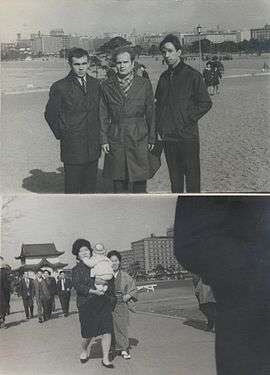
Remarks: The ship was anchored and crew visited city by motor boat, but in the verse mentioned "moored". “Forty-Seven” is Odessa city dance, the rate of which increases during the dance to extremely if the dancers have enough power. This verse is folk art.[16][17]
Weekly checks on the ship and call in Japan
A weekly check of crew members cabins, galley, storages was carried out by the master (captain) or chief mate in presence of one more crew member as witness. It is the custom of every Soviet merchant ship. Due to one of weekly checks the cadet's cabin was in bad condition. The cadets had to give a report-explanation to the chief mate in written form and they wrote a verse as the report-explanation to the Chief Mate Demiyanenko (Russian: Демьяненко). This happened during Australian voyage and can be before the call in Japan. The Nikolay brought at home copies of the verse Call to Nakhodka and this verse. His son named this verse Сhelobitnaya (On Russian Челобитная; on English Petition).
The crew members went on shore in Japan and photos dated March 1964 attached here. On the one of two photo crew members in Japan: Chief Mate Demyanenko on the right, Nikolay in the center and unknown crew member on the left (Nikolay does not remember his name and rank).
In March 1964 the ship sailed from Japan, crossed Equarot line at Longitude 154° 00' E on the 14 of March 1964. Destination port was Sydney, Australia.
Call in Sydney
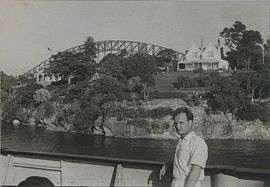

On arrival at Sydney the ship dropped anchor at outer anchorage and awaiting free berth for loading. The ship Metallurg Anosov proceeded to the berth for mooring on 4 April 1964 about. The cargo for loading was grain. After completion of loading crew members were placed in private hotel "Mansion House", 178 Elizabeth Street, Sydney.[18] The crew was placed in the hotel for three day about and then was back on board of ship for sailing.
About one photo
.jpg)
Mostly people know that miners took first place in the mortality rate during the works. But Soviet seamen took first place in the mortality during the works at sea and rest, vacation in case the death due to secret operations as ruzvedka, special traffics at sea. Of course this figures nobody demonstrate. This is information from the one non-Soviet "Servicio Secreto".
The photo on the right was made in Odessa or Novorossiysk port, after completion of Australian voyage, and dated May or summer 1964.
On right side of the photo:
Woman and two girls in identical dresses are the wife and daughters of chief mate Mozalyov (Russian: Мозалёв). Daughters often brought yellow flowers for the father. Mozalyov went to the beach at Novorssiyske, dived and was drowned. Tried to do artificial respiration on the beach and it did not help. Said that the cause was a stroke of heart. Perhaps this photo was taken shortly before the death of chief mate Mozalёv. In Russian and Ukrainians have a sign: yellow flowers on the separation. Nikolay told his son: "Flowers do not present to seafarers. Flowers present to men of arms."
In the center at the bottom of the photo:
Ship's electrician Alexander Snyesar (Russian: Снесарь) and his wife Olga sat down close to their daughter.
On left side of photo:
Nikolay and his son. The hair of the son is white and curly like shavings. The nickname of the son was "unknown small beast" from the date of born 29 of September 1962. The ship Metallurg Anosov was built finally and handed over to Black Sea Shipping Company at the same date. The wife of Nikolay, mother of his son, stands alittle to the right and behind the family Snyesar.
Others he does not remember.
Also interesting investigations regarding women dresses on this photos, but for this reason better to write separate article about seamen's families of Black Sea Shipping Company in 1950s and 1960s.
Voyage from August 1964 to January 1965
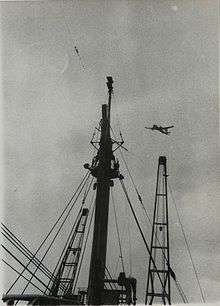
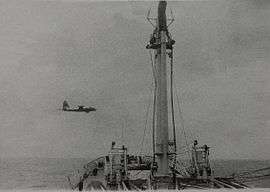

The ship sailed from Black Sea to Japan through Suez Canal in Agust 1964. From Japan Metallurg Anosov passed to Cuba through the Panama Canal. From Cuba the ship back to Japan through Panama Camal to discharge cargo sugar in Japan. Then vessel run to Singapore to load caoutchouc.[19]
During the cargo operation in Singapore crew members walked on the Singapore Island and one incident gave a reason for the third verse. Some crew members walked to shore thelephon station to make call at home. The motorman Babyenko (do not mix with this ship captain's name Babiyenko) tried to climb up on a palm tree to take coconuts, but fall down from the palm. The motorman intended to be married after the voyage and his bride name was Lyusya (English: Lucy) and often called she by telephone. Another motorman Rodchenko wrote the comic verse about this incident and the match Babyenko and Lyusya.
After Singapore the ship back to Black Sea and discharged cargo in Illichevsk port in January 1965.
Later, in 1967 or after, humorous artist Zinovy Vysokovsky began to perform the comic reprises Hello, Lyulyok! on the Soviet television and radio. In some sources mentioned, that Lyulyok and Lyusya are the short names of Yuliya and Lyuda.[20][21] But everybody can say that Lyulyok is Lyalya and Lyalya is Lora. Also Lyusya can be Lyulya, Lyusik and Lyulyok. It is Russian play by the names, which are not officially and do not mention in the passports.
In 1970-s another humorous artist Efim Shifrin began to perform the comic reprises Hello, Lyusya! on the Soviet television, his reprises were the continuation after Zinovy Vysokovsky reprises about Lyulyok. In 1968-1971 one girl Lyusya was lived nearby Nikolay and his son adored she. Soon Lyusya and her parents changed the housing, but Intelegence Center tried to make contact with the young boy by reprises Allo, Lyusya!. Аctors family name Shifrin was formed from the Russian word "шифр" or "шифровка" (English: encryption). But this communication was not accepted by the Nikolay's son, he was not beleave in this persons and did not want to reply Lusya, who was already far away and unvisible.
Аnother poet Radchenko (he is not Rodchenko, he is Radchenko only one character difference) wrote own verses in Nikolayev city. But can be Rodchenko and Radchenko the same person as Radchenko wrote the verses about seamen also.
From 1965 to 1967
Next voyages of Metallurg Anosov was from Black Sea to Cuba and back. One time during period from 1965 to 1967 a US old destroyer tried to reach Metallurg Anosov from the stern direction when this Soviet ship sailed from Cienfuegos. Metallurg Anosov was in cargo condition and increased speed up to 24 knots and the destroyer was not able to reach the ship. It was possible to run 24 knots for this ship but in this case had place very big consumption of bunker and risk to damage engines. It is why this class of ships did not declared 24 knots in cargo condition or 25 knots in ballast condition.[19]
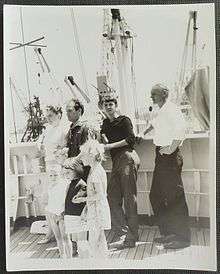
The ship also visited Alexandria and Algeria between 1965 and 1967.[19][22]
The ship brought into Algeria, Algeria port, military cargo. The deep sea captain Stadnichenko, during this voyage he was the junior mate of the ship Metallurg Anosov, recalls the Algeria port events:
"When the ship Metallurg Anosov was moored alongside the berth it was necessary to work periodicaly by propeller ahead and then back to avoid diver's actions against the ship. Also Algerian soldier with automatic gun was on board. One time the crew members heard the shots of automatic gun. The soldier was on main deck and heard the breathing from water. He fired into water and a dolphin was killed".[19]
Chief motornam Nikolay recalls that one military motor boat run around the ship, when the she stay in Algeria, and periodically did underwater explosions to avoid diver's actions.[22]
Around Africa in 1967 to 1969 years
During the Six-Day War in June 1967 Israel occupied the Sinai Peninsula and the eastern side of the canal. The Suez Canal was closed for shipping between 1967 and 1975 due to the Arab-Israeli wars.[23]
Therefore, "Metallurg Anosov" from 1967 until 1975 run around Africa and visited South Africa ports for bunkering due to voyages from Black Sea to the Asian ports in Indian and Pacific Oceans. So, the ship crossed again the Equator line at Longitude 009° 30' W on 24 of July 1967, the captain on board was Kolesnichenko. The crew received the Equator Line Crossing Certificates.
Circumnavigation including Equator Line Crossing (1969-1970)
According to another Certificate of the Equator crossing "Metallurg Anosov" commenced circumnavigation when sailed from Odessa to Cuba. After Cuba in late 1969 or early January 1970 the ship passed through the Panama Canal and run to Japan. Equator line was crossed in the Atlantic Ocean in March 1970. Then the ship passed around Africa and seems received bunker (fuel oil, diesel oil) and other ship's supply in a South Africa port. According to the Circumnavigation and Equator Line Crossing Certificate, the ship crossed Equator Line in March 1970 and she had to back in Odessa due to this port was mentioned in the Certificate as the port of arrival, but the Certificate was filled before the Turkish Straits approaches, and can be before the Equator Line crossing ceremony. Seems the port of arrival was changed and the ship arrived in Tuapse port due to it is confirmed by document "Inspection of Tuapse Customs" dated 17 of March, 1970.
Missile's Carrier or Мысль's Carrier
Yura-Grisha and Yuriy-Grigoriy
There are small quantity of people know, that prior to 1931 Yuri Vladimirovich Andropov had the name Grigory Vladimirovich Andropov-Fyodorov. It is unknown, when he became a Yuriy and lost half of the name. Also absent information about his biological father (name unknown) and two stepfathers. Like a professional revolutionary or a spy, he several times altered his life story, successfully tricking the native state.[24]
The name Yuriy-Grigoriy was written in Yuriy Andropov birth certificate.[25] Fyodorov was his stepfather's family name.[26] Yuriy-Crigoriy has short name Yura-Grisha.
Andropov's birth certificate is here: http://sputnikipogrom.com/wp-content/uploads/2015/10/andr1xbig.jpg
The son of the Metallurg Anosov chief motorman Nikolay received name Yuriy, it was mentioned in his birth certificate, short name is Yura. During the summer of 1971 year the son Yura was replaced to from one school in Odessa another new built school in the same city. His education in a Forth Grade class commenced in September, 1971 and when a teacher called the roll of disciples, one boy shouted new nicknames of some schoolboys and schoolgirls acording to their family names and given names. Yura receved new name (nickname) Grisha due to his family name was created from this name some centuries ago. So, Yura became Yura-Grisha, full name must be written Yuriy-Grigoriy. Seems any Soviet secret organization found his father with appropriate family name to be married his mother Zhukovskaya.
To understand clear this chapter the reader has to read following articles in Wikipedia:
- Mister X (1958 film)
- Statue of Yuriy Dolgorukiy, Moscow
- Statue of Graf Vorontsov, Odessa
- Statue of Metallurgist Anosov, Zlatoust
This is article about ship Metallurg Anosov, it is why will write shortly about linkage between the ship and Yura-Grisha.
Мысль's Carrier
Soviet Intelligence Center had doubt that the foreign Intelligence services know about this boy Yura-Grisha and organized look out for him. Fireign Services could have interest to this boy due to:
- His grandfather's and his mather's family name was Zhukovskiy(-aya), and it was a family of the indigenous inhabitants of East Prussia before Germans entered this area. The Soviet Union signed the agreement after World War II to back East Prussia to Germany in 1996, and this boy could be the problem.
- The boy's behavior raised the question: "Is he already a robot partly?" Only special peaples were close to him and his replacement in the new school was looking like replacement in spy traning center.
- Foreigh Intelligence Services was not sure that the Soviet Intelligence know that the boy under their look out and was thinking: "If Soviet Intelligence Center tried to study this boy as a spy, we will see their system of the training and others".
Ruzvedka (razvedka) is the game of thoughts first of all. The Soviet Intelligence Center tried to play this game via the ship Metallurg Anosov. The part of information reached the boy from this ship due to crew, except the amster and his father, was changed often and various verses, smile histories, cases, event, e.t.c. were said to boy's father Nikolay, who retold all to the son and did not understood for what reason mostly. Foreign Intelligence Services woke up about it when it was later and when the game became more interesting.
So, the Soviet Inteligence Center thoughts were sent to this boy via the ship. It was wonderfull due to the thoughts had to be in foreign voyage first of all, and than, when the ship back to home port, the thoughts reached the boys ears. And more interesting the fact that some verses, smile histories, cases, event, e.t.c. was not prepaired by the Soviet Intelligence Center and were spontaneous due to people told not only beforehand prepaired stories, verse, e.t.c. The Soviet Intelligence Center tried to use and spontaneous messages also and was difficulty to understand for the foreing Centres what about and what is the spe theme and what is the other themes.
Though on Russian language is Мысль (Myssile). It is why this chapter named "Missle's Carrier or Мысль's Carrier" ("Missle's Carrier or Myssile's Carrier"). The boy's father joined the ship Metallurg Anosov in 1964 and seems from this year the ship became a missile carrier until 1980, when the boy's father was replaced to another crew of the ship Metallurg Baykov.
Pinocchio
The first partial translation on Russian of the tale "The Adventures of Pinocchio. The history of the wooden doll." by Carlo Collodi was published in Russian journal "Sincere word" (Russian: "Задушевное слово") (No. 1, p. 14-16) in 1906. The first full translation on Russian of this tale was carried out by Soviet writer, poet, translator, screenwriter Emmanuil Kazakevich, who wokred in Intelligence Service of one of Soviet armies during the World War II and had become assistant director of intelligence in one of the armies. His translation of "The Adventures of Pinocchio" was first time published in 1959.[27][28]
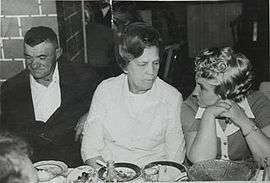
Last years of own life, 1961 and 1962, Emmanuil Kazakevich dedicated to gather information for the conceived story "Foreign Board" (Russian: "Иностранная коллегия") about the underground Bolshevik organization, founded in Odessa in 1919. "Among the heroes of the story was Frenchwoman Jeanne Lyabor, Lenin wrote about she. She was killed and buried in Odessa.[29] It is means, that Emmanuil Kazakevich investigated relationships in Odessa city during the "Operation Anadyr", when Odessa port was the main port of this operation in the Soviet Union.
Emmanuil Kazakevich died on the 22 of September, 1962. Serious illness struck him in the midst of working to implement interesting and promising ideas.[29] Could he to address the existing secret organisation and relationships in Odessa during the information research for the own new book? Yes. The son of Nikolay, who became later a motorman on the ship Metallurg Anosov, was born on the 29 of September, 1962. In September 1962, "Operation Anadyr" was in progress and in October Cuban crisis had place due USA was good informed about Soviet secret operation.
Crew members of the ship Metallurg Anosov bought syntetic perukes for their wives in foreign ports in 1971 about and the perukes became fashionable in Odessa. Wife of Nikolay, mother of his son Yura, is like a Pinocchia on the photo (to see photo on the right).
A library was on board of the ship Metallurg Anosov, which was supplemented with new books periodically by Black Sea Shipping Company. That were books for about 50 adult crew members. When the ship arrived in home port or any Soviet Black Sea port seamen's wifes and their children joined the ship, but the library was closed for that period as usually. During the stay in one Soviet Black Sea port, seems in Odessa, in 1971 or 1972, the father Nikolay brought the book "The Adventures of Pinocchio" (1959) in own cabin for the son Yura, who read it during the short period. The book was good illustrated.
As result of all above mentioned, the new nick name Pinocchio was given to the boy Yura-Grisha. During the own Intelligence show in the second part of 1990-s he told that the book "Pinocchio" was the first his manual instruction, he told it like a joke, but after everybody understood that it could be really. You see, the man had to to pass inside the foreing Intelligence service organization, and in the book mentioned that Pinocchio trapped in the stomach of a shark, which was associated with the foreign Intelligence center. Of course, later the people took out Pinocchio from the stomack, the same must be when Intelligence agent had to be taken back.
This is only one story how the information was given to the boy, 10 years old about, via this ship. The boy kept in memory only some episodes of the book, which he understood later, when was necessary as per situation.
Again Around Africa in 1971-1975 years
The ship was in a Black Sea Soviet port in February 1971.[30]
"Metallurg Anosov" skirted the cyclone epicenter, 8 points as per Beaufort scale, when she came back from Cuba in 1971 about. Waves ten metres high struck the deck. Big heel happened due to lashing wires were parted in cargo hold number 3 and cargo began to move. The ship was in danger, but raised alarm and deckhands under the leadership of the chief mate and the boatswain tried closed the problem. The hard works continued for more than three hours despite the severe storm. The cargo was lashed and secured by sailors team reliably.[31]
The ship visited Katar one time only, - the visit could be between 15 of April 1971 and February 1973.
The ship visited Ceylon in the second part of January 1973.[32]
The ship was on Cuba in the end of March and in May 1973.[33] After the Cuba the ship was loaded in USA and proceeded to Beirut for discharge. After Beirut the ship back in the USSR.
During the next voyage from the USSR the ship arrived on Cuba in the second part of September and sailed from Habana оn the 7 of October 1973 about to Canada. The ship was loaded grain in Canada and arrived in Odessa in the second part of November 1973, but before arrival was planned Novorossisk port.[33]
In accordance with the Agreement about disengagement on the Sinai Peninsula dated 18 of January 1974, Israel pulled own troops to the East from the Suez Canal and Egypt regained control over the narrow strip along the eastern bank of the Canal.[23]
As per crew member and his family letters the ship Metallurg Anosov was on Cuba in January, April, second part of June and in July 1974.[33]
The ship was on Cuba in the end of March and in April 1975.[33]
US Navy and the Soviet Union Navy forces opened Suez Canal for navigation after demining, on 5 of June 1975.[23]
The ship was in Haiphong port, Vietnam, in the second part of June and in the first part of August 1975[33]
To see photo: Металлург Аносов in ballast condition. The photo dated between March 1970 and 1975.
From 1976 to 1986
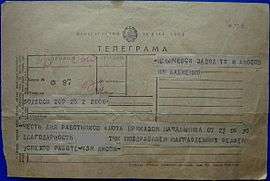
To: ship Metallurg Anosov in Illichevsk Shipyard, captain Babiyenko.
"In honour of the Day of Sea Workers and as per Decree of the Head of Shipping Company dated 23 of June 1976 it is declared a gratitude to Nicholay (surname is closed). Congratulations to the awarded crew members, we wish success in your works. ChZM Lisyuk".
The telegram was sent on the 2nd and received on the 3 July 1976.
Metallurg Anosov visited Angola once, in 1976, - the ship brought military cargo in Luanda. The voyage to Angola, as well as voyages to Cuba during the Cuban Missile Crisis, was counted for the crew members to receive the supplementary pension from the the second part of 1990-s.
The ship was under repair in Ilyichevsk Shipyard in Summer 1976. The telegram confirm it.
Metallurg Anosov arrived in Odessa from Rijeka on 19 of February, 1977.
In 1977 about, Nikolay's son, Pinocchio, used the style of the verses Call to Nakhodka and Chelobitnaya (to see Australian voyage) as teaching program to write own first verse in the school during the short time and Western Servicio Secretos had not understood clear who wrote that verse - the Pinocchio or Razvedupr transmited the text by special radio canal into the brains of Pinoccio. In future, mentioned here verses and future verses of Pinocchio and one from another ship were collected in the serie The verses during the Intelligence service in 2000 year about and some other verses added later. One of this verses, the most famous, received name Geisha (he-geisha). Geisha was the sad part of Pinocchio activity and it was the commencement of another his activity under name The best girl-frend, which was one of the Pinocchio's Intelligence activity styles in 1990-s and included too much humor. So, the sadness was changed by the increasing of humor.
The ship was on Cuba in the first part of May 1979.[33]
The fate
Metallurg Anosov was sold for scrap on 21 of March 1986 and renamed Anosov.[1] The ship's home port and flag were changed to George Town, Cayman Islands. The ship arrived in China in May 1986. Anosov proceeded to Qinhuangdao and scrapped on 22 of May 1986.[34]
Stamps
- Stamp issued in 2008. On this stamp painted Metallurg Anosov and not Metallurg Kurako as Metallurg Kurako had not carried missiles from Cuba back to USSR. Can be mistake due to Anosov and Kurako are sister ships. Only here is color of the Metallurg Anosov hul is black that was some years later. But position of missiles on the open deck the same as was on Metallurg Anosov.
- [http://www.shipstamps.co.uk/forum/viewtopic.php?f=2&t=12924#!lightbox[gallery]/1/ Stamp issued in 2013. The hull color if correct on this stamp.]
Only one Soviet ship Metallurg Anosov mentioned on the Cuban Missile Crisis and Cold War stamps due to this ship was involved in invisible game during the Cold War also.
References
- 1 2 3 4 5 6 Металлург Аносов.
- ↑ Проект 567, 567К, тип Ленинский комсомол.
- 1 2 3 4 5 6 7 8 9 10 11 12 13 14 Вечерний Николаев. Вкус морской воды.
- ↑ СССР в строительстве ВМС Кубы. 8. Советские суда участвовавшие в переброске войск в ходе операции «Анадырь».
- ↑ Цусимские форумы. История войны с древнейшего времени до наших дней. 23.07.2012 16:49:55
- ↑ Кубинцы приветствовали нас словно космонавтов.
- 1 2 DIP Comments > Самая большая переброска войск в истории человечества. Автор: Аурагх Рамдан.
- ↑ Блокада экономическая // Советская военная энциклопедия (в 8 тт.) / под ред. Н. В. Огаркова. том 1. М.: Воениздат, 1976. стр.503
- ↑ Newspaper Chicago Sanday Tribune от 11 ноября 1962 года. > A Close Look by Sea and Air.
- ↑ Хроника операции «Анадырь».
- ↑ Newspaper "Utica Observer-Dispatch", Sunday Morning, November, 11, l962. Page 2a. Article: "41 of 42 Cuba Missiles Believed Russia-Bound V".
- 1 2 Хронос. "Карибский кризис".
- ↑ The attached photo confirm it.
- ↑ Nezhin
- ↑ The verse translated by Y.N. Gryshchuk.
- ↑ The copy of this verse saved by engine department crew member Nikolay and by his son.
- ↑ The examples of Odessa city dance "Seven Forty", it is not a Jewish dance (Jawish dances are not so rapidly and last 50 years includes Moldavian or Balcanian style) as mentioned today mostly, it is mix Moldavian and Jawish music, movements, and Odessa very close to Moldavia:
- ↑ To see the photo of the guide of the private hotel "Mansion House"
- 1 2 3 4 Deap sea captain Stadnichyenko S.M. was a junior deck officer on the Metallurg Anosov between August 1964 and 1967 and He refreshed in memory the voyages during this period.
- ↑ Зиновий Высоковский: «Я - Люлек Советского Союза!»: "Откуда взялось странное имя Люлек? - Это же уменьшительное от Юлии".
- ↑ Зиновий Высоковский - Люлёк и другие всенародно избранные монологи (1996/MP3).
- 1 2 Confirmed by Engine department crew member Nikolay.
- 1 2 3 "Искусственный Босфор": зачем Египту второй Суэцкий канал.
- ↑ Cite: "Красноярское Время" >> Александр Север: "Что скрывал о себе Юрий Андропов?"
- ↑ Млечин Леонид Михайлович: "Юрий Андропов. Последняя надежда режима." >> Сирота с сомнительной анкетой. Page 8
- ↑ Млечин Леонид Михайлович: "Юрий Андропов. Последняя надежда режима." >> Сирота с сомнительной анкетой. Page 10
- ↑ To see Russian Wikipedia articles: "Пиноккио"; "Казакевич, Эммануил Генрихович".
- ↑ To see English Wikipedia article: "Emmanuil Kazakevich", where mentioned "His war service brought him close to some of the major battles of 1943-45 and finally into the battle for Berlin; by this time he had become assistant director of intelligence in one of the armies involved."
- 1 2 Л.А. Гладковская: "Эммануил Казакевич", page 8.
- ↑ Due to crew change
- ↑ Мой город Херсон » Организации Херсона » Херсонский судозавод » «Герои-панфиловцы» и «Командарм Федько» — суда нового поколения (ч.2).
- ↑ As per photo in collection.
- 1 2 3 4 5 6 As per direction of the seaman and his family letters.
- ↑ ShipsStamps.co.uk > Search found 1 match: METALLURG ANOSOV.
To read to understand above mentioned
| Wikimedia Commons has media related to Metallurg Anosov (ship, 1962). |
- Statue of Graf Vorontsov, Odessa
- Statue of Yuriy Dolgorukiy, Moscow
- Statue of Metallurgist Anosov, Zlatoust
- Tamer of Tigers
- SS Nezhin
- Mister X (1958 film)
- SS Karaganda
- SS Metallurg Anosov
- MS Toyvo Antikaynen
- MS Sarny
See also
- Operation Anadyr
- Cuban blokade
- Cuban Missile Crisis
- Leninsky Komsomol class of cargo ships
- SS Leninsky Komsomol
- SS Metallurg Baykov
- ↑ Розин Александр. "СССР в строительстве ВМС Кубы. >> Chapter 8: Советские суда участвовавшие в переброске войск в ходе операции «Анадырь».".